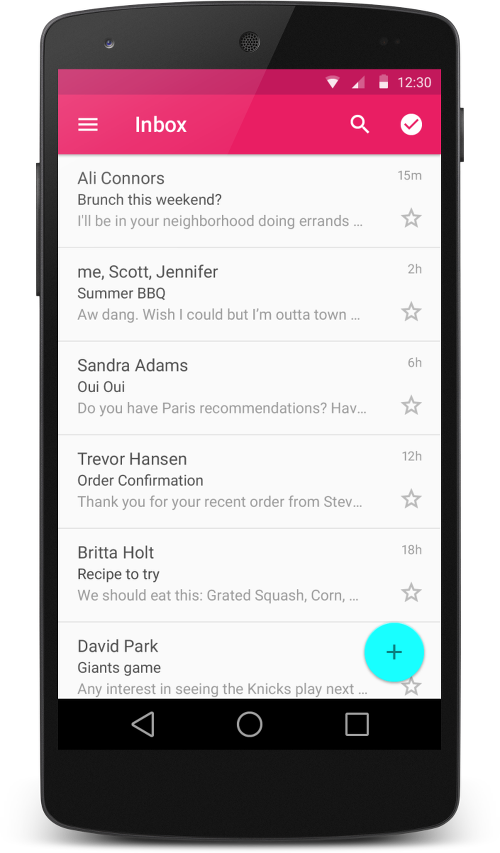Creating Lists and Cards 创建列表和卡片
To create complex lists and cards with material design styles in your apps, you can use the RecyclerView and CardView widgets.
//想要创建复杂的带有material design风格的列表,使用RecyclerView 和 CardView widget
Create Lists
The RecyclerView widget is a more advanced and flexible version of ListView. This widget is a container for displaying large data sets that can be scrolled very efficiently by maintaining a limited number of views. Use the RecyclerView widget when you have data collections whose elements change at runtime based on user action or network events.
The RecyclerView class simplifies the display and handling of large data sets by providing:
- Layout managers for positioning items
- Default animations for common item operations, such as removal or addition of items //对移除或者添加等常用条目的行为都有默认的动画
You also have the flexibility to define custom layout managers and animations for RecyclerView widgets.

Figure 1. The RecyclerView widget.
To use the RecyclerView widget, you have to specify an adapter and a layout manager. To create an adapter, extend the RecyclerView.Adapter class. The details of the implementation depend on the specifics of your dataset and the type of views. For more information, see the examples below.

Figure 2 - Lists with RecyclerView.
A layout manager positions item views inside a RecyclerView and determines when to reuse item views that are no longer visible to the user. To reuse (or recycle) a view, a layout manager may ask the adapter to replace the contents of the view with a different element from the dataset. Recycling views in this manner improves performance by avoiding the creation of unnecessary views or performing expensive findViewById() lookups.
//layout manager负责排布recyclerview中的视图条目,并且决定当一些条目不在可见时什么时候重用条目。为了重用view,layout manager可能会向adapter请求用不同的数据库的数据带替换view中的内容。
RecyclerView provides these built-in layout managers:
LinearLayoutManagershows items in a vertical or horizontal scrolling list. //以水平或者垂直的滚动列表形式显示条目GridLayoutManagershows items in a grid. //以网格形式显示StaggeredGridLayoutManagershows items in a staggered grid.//以交错网格形式展示
To create a custom layout manager, extend the RecyclerView.LayoutManager class.
Animations
Animations for adding and removing items are enabled by default in RecyclerView. To customize these animations, extend the RecyclerView.ItemAnimator class and use the RecyclerView.setItemAnimator()method.
//为了定制动画,继承RecyclerView.ItemAnimator 类,并且使用RecyclerView.setItemAnimator()方法来设置
Examples
The following code example demonstrates how to add the RecyclerView to a layout:
- <!-- A RecyclerView with some commonly used attributes -->
<android.support.v7.widget.RecyclerView
android:id="@+id/my_recycler_view"
android:scrollbars="vertical"
android:layout_width="match_parent"
android:layout_height="match_parent"/>
Once you have added a RecyclerView widget to your layout, obtain a handle to the object, connect it to a layout manager, and attach an adapter for the data to be displayed:
- public class MyActivity extends Activity {
private RecyclerView mRecyclerView;
private RecyclerView.Adapter mAdapter;
private RecyclerView.LayoutManager mLayoutManager;- @Override
protected void onCreate(Bundle savedInstanceState) {
super.onCreate(savedInstanceState);
setContentView(R.layout.my_activity);
mRecyclerView = (RecyclerView) findViewById(R.id.my_recycler_view);- // use this setting to improve performance if you know that changes
// in content do not change the layout size of the RecyclerView
//使用这个设置来提高性能,如果你已经知道了内容的修改不会改变recyclerview的布局大小
mRecyclerView.setHasFixedSize(true);- // use a linear layout manager
mLayoutManager = new LinearLayoutManager(this);
mRecyclerView.setLayoutManager(mLayoutManager);- // specify an adapter (see also next example)
mAdapter = new MyAdapter(myDataset);
mRecyclerView.setAdapter(mAdapter);
}
...
}
The adapter provides access to the items in your data set, creates views for items, and replaces the content of some of the views with new data items when the original item is no longer visible. The following code example shows a simple implementation for a data set that consists of an array of strings displayed using TextView widgets:
- public class MyAdapter extends RecyclerView.Adapter<MyAdapter.ViewHolder> {
private String[] mDataset;- // Provide a reference to the views for each data item
// Complex data items may need more than one view per item, and
// you provide access to all the views for a data item in a view holder
public static class ViewHolder extends RecyclerView.ViewHolder {
// each data item is just a string in this case
public TextView mTextView;
public ViewHolder(TextView v) {
super(v);
mTextView = v;
}
}- // Provide a suitable constructor (depends on the kind of dataset)
public MyAdapter(String[] myDataset) {
mDataset = myDataset;
}- // Create new views (invoked by the layout manager)
@Override
public MyAdapter.ViewHolder onCreateViewHolder(ViewGroup parent,
int viewType) {
// create a new view
View v = LayoutInflater.from(parent.getContext())
.inflate(R.layout.my_text_view, parent, false);
// set the view's size, margins, paddings and layout parameters
...
ViewHolder vh = new ViewHolder(v);
return vh;
}- // Replace the contents of a view (invoked by the layout manager)
@Override
public void onBindViewHolder(ViewHolder holder, int position) {
// - get element from your dataset at this position
// - replace the contents of the view with that element
holder.mTextView.setText(mDataset[position]);- }
- // Return the size of your dataset (invoked by the layout manager)
@Override
public int getItemCount() {
return mDataset.length;
}
}

Figure 3. Card examples.
Create Cards
CardView extends the FrameLayout class and lets you show information inside cards that have a consistent look across the platform. CardView widgets can have shadows and rounded corners.
To create a card with a shadow, use the card_view:cardElevation attribute. CardView uses real elevation and dynamic shadows on Android 5.0 (API level 21) and above and falls back to a programmatic shadow implementation on earlier versions. For more information, see Maintaining Compatibility.
//为了创建带有阴影的卡片,使用card_view:cardElevation属性,cardview使用真是的正视图和动态的阴影效果在Android 5.0及以上的平台上,在较早版本上使用代码来实现。
Use these properties to customize the appearance of the CardView widget:
- To set the corner radius in your layouts, use the
card_view:cardCornerRadiusattribute. //为了设置布局的圆角,使用card_view:cardCornerRadius属性 - To set the corner radius in your code, use the
CardView.setRadiusmethod. //在代码中设置圆角,使用CardView.setRadius方法 - To set the background color of a card, use the
card_view:cardBackgroundColorattribute. //给卡片设置背景的属性
The following code example shows you how to include a CardView widget in your layout:
- <LinearLayout xmlns:android="http://schemas.android.com/apk/res/android"
xmlns:tools="http://schemas.android.com/tools"
xmlns:card_view="http://schemas.android.com/apk/res-auto"
... >
<!-- A CardView that contains a TextView -->
<android.support.v7.widget.CardView
xmlns:card_view="http://schemas.android.com/apk/res-auto"
android:id="@+id/card_view"
android:layout_gravity="center"
android:layout_width="200dp"
android:layout_height="200dp"
card_view:cardCornerRadius="4dp">- <TextView
android:id="@+id/info_text"
android:layout_width="match_parent"
android:layout_height="match_parent" />
</android.support.v7.widget.CardView>
</LinearLayout>
For more information, see the API reference for CardView.
Add Dependencies
The RecyclerView and CardView widgets are part of the v7 Support Libraries. To use these widgets in your project, add these Gradle dependencies to your app's module:
- dependencies {
...
compile 'com.android.support:cardview-v7:21.0.+'
compile 'com.android.support:recyclerview-v7:21.0.+'
}
Creating Lists and Cards 创建列表和卡片的更多相关文章
- Android Material Design-Creating Lists and Cards(创建列表和卡)-(三)
转载请注明出处:http://blog.csdn.net/bbld_/article/details/40430319 翻译自:http://developer.android.com/trainin ...
- Material Design系列第八篇——Creating Lists and Cards
Creating Lists and Cards //创建列表和卡片 To create complex lists and cards with material design styles in ...
- Android(Lollipop/5.0) Material Design(四) 创建列表和卡片
Material Design系列 Android(Lollipop/5.0)Material Design(一) 简单介绍 Android(Lollipop/5.0)Material Design( ...
- Creating Apps With Material Design —— Creating Lists and Cards
转载请注明 http://blog.csdn.net/eclipsexys 翻译自Developer Android.时间仓促,有翻译问题请留言指出,谢谢 创建Lisst和Cards 在你的应用程序创 ...
- 使用Material Design 创建App翻译系列---列表和卡片集的创建
上一篇是使用Material Design 创建App翻译系列--材料主题的使用(Using Material Theme),进入正题: 想要在应用里创建Material Design风格的复杂列表和 ...
- sharepoint 2010 使用自定义列表模版创建列表(2)
前面用的方法是通过界面上操作,根据自定义模版,创建的列表.sharepoint 2010 使用自定义列表模版创建列表(1) 这里顺便记录多另一种方法,通过程序来创建. ---------------- ...
- SharePoint 创建列表并使用Windows Presentation Foundation应用程序管理列表
SharePoint创建列表并使用程序管理列表 列表是SharePoint开发者输入数据的方式之中的一个.使用Web界面创建一个列表并加入一些数据.过程例如以下: 1. 打开站点. 2 ...
- SharePoint2010新特性:InfoPath定义创建列表的界面
在SharePoint2007的时候,自定义的列表可以使用CAML修改其展示页面,但是对于创建列表的页面,不容易自定义.现在在SharePoint2010中,增强了InfoPath Form Serv ...
- 《Python CookBook2》 第四章 Python技巧 - 若列表中某元素存在则返回之 && 在无须共享引用的条件下创建列表的列表
若列表中某元素存在则返回之 任务: 你有一个列表L,还有一个索引号i,若i是有效索引时,返回L[i],若不是,则返回默认值v 解决方案: 列表支持双向索引,所以i可以为负数 >>> ...
随机推荐
- Java数据库连接池的几种配置方法(以MySQL数据库为例)
Java数据库连接池的几种配置方法(以MySQL数据库为例) 一.Tomcat配置数据源: 前提:需要将连接MySQL数据库驱动jar包放进Tomcat安装目录中common文件夹下的lib目录中 1 ...
- codevs 1139 观光公交
#include<cstdio> #include<cstdlib> #include<cstring> #define max(a,b) (a > b ? ...
- 78 Subsets(求子集Medium)
题目意思:求解一个数组的所有子集,子集内的元素增序排列eg:[1,3,2] result:[],[1],[2],[1,2],[3],[1,3],[2,3],[1,2,3]思路:这是一个递推的过程 [] ...
- Lang语言包
\languages\zh_cn\admin\common.php里配置后台所有常量
- HTTP协议学习-01
在学习一门新知识前还是先了解一下这个知识的一点点背景吧! http是属于协议层当中的最顶层的应用层,的面向对象的协议:它于 1990 年提出, 经过几年的使用与发展, 得到不断地完善和扩展. 目前在 ...
- Js监控回车事件
标题通俗的说,也就是绑定当用户按下回车键要执行的事件. 下面,入正题. 第一步,先编写简单的页面代码,这里我们只需要一个按钮就足够了.当然,还有按钮事件. <html> <head& ...
- jQuery显示与隐藏返回顶层的箭头
<script type="text/javascript"> $(window).scroll(function(){ var d ...
- mschedule 简单linux进程管理(树莓派)
树莓派是神奇的机器,CPU和内存都少的可怜,但体积小功耗低,在上面搞些动搞些西其实也挺有意思,挺好玩的.装的是pidara,基本服务没有精简多少,先cat一下CPU和RAM. [able@raspi ...
- 转:前端集锦:十款精心挑选的在线 CSS3 代码生成工具
今天这篇文章向大家推荐十款非常有用的在线 CSS3 代码生成工具,这些工具能够帮助你方便的生成 CSS3 特效.CSS3 是对 CSS 规范的改善和增强,增加了圆角.旋转.阴影.渐变和动画等众多强大的 ...
- 实现一个基于tcc/tlink的简单的编译链接工具
一.基础研究 在这里我们需要提供一套新的c语言开发工具cc,它支持的c程序不是从main开始运行而是从CMain开始运行. 书上已经对该工具程序进行了需求分析:(1)要在屏幕中间显示彩色的字符串:(2 ...
